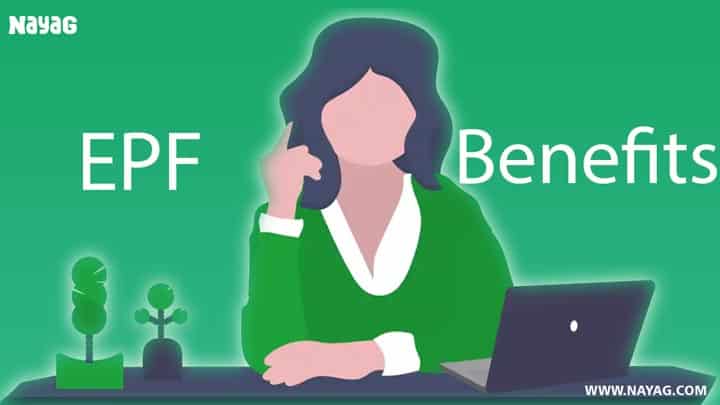EPF is the main scheme under the Employees’ Provident Funds and Miscellaneous Act, 1952. The employee and employer each contribute 12% of the employee’s basic salary and dearness allowance towards EPF. Currently, the rate of interest on EPF deposits is 8.50% p.a.

EPFO (Employee Provident Fund Organization)
The Employees’ Provident Fund Organisation (EPFO) is a non-constitutional body that promotes employees to save funds for retirement. The organisation is governed by the Ministry of Labour and Employment, Government of India and was launched in 1951.
The schemes offered by the organisation cover Indian workers and international workers (from countries with whom the EPFO has signed bilateral agreements).
Also Read- PM Schemes List
Union Budget 2021 Highlights:
Your retirement savings to take a hit –
During the Union Budget 2021, the Ministry of Finance announced that the tax-free return for Unit Linked Insurance Plans (ULIPs) and Provident Funds (PFs) have been restricted at Rs.2.5 lakh each.
Previously, a limit of Rs.7.5 had been imposed on the employer’s contribution to PF. Now contribution above Rs.2.5 lakh will be taxable during the time of withdrawal of the PF amount.
Earlier, if you had paid premiums less than 10% of the total insurance cover, than the maturity amount would not be taxable. However, now any amount above Rs.2.5 lakh will be taxed by the government.
Objectives of EPFO
Given below are the main objectives of the EPFO:
- To ensure every employee has only one EPF account.
- Compliance must be facilitated easily.
- Make sure organisations follow all the rules and regulations set up by the EPFO on a regular basis.
- To ensure that online services are reliable and to make improvements in their facilities.
- For all member accounts to be accessed online easily.
- Claim settlements to be reduced from 20 days to 3 days.
- Promotion and encouragement of voluntary compliance.
Universal Account Number (UAN)
All subscribers of EPF can access their PF accounts online and perform functions like withdrawal and checking EPF balance. The Universal Account Number (UAN) makes it convenient to login to the EPFO member portal.
The UAN is a 12-digit number alloted to each member by EPFO. The UAN of an employee remains the same even after he/she switches jobs. In the event of a job change, the member ID changes, and the new ID will be linked to the UAN. However, employees must activate their UAN in order to avail the services online.
You can get your UAN through your employer. In case you are unable to do so, you can easily login to the UAN portal (https://unifiedportal-mem.epfindia.gov.in/memberinterface/) with your member ID and find the UAN.
Alos Read- PMSBY
Schemes Offered Under the EPFO
Given below are the various schemes that are present under the EPFO:
- Employees’ Provident Funds Scheme 1952 (EPF)
- Employees’ Pension Scheme 1995 (EPS)
- Employees’ Deposit Linked Insurance Scheme 1976 (EDLI)
EPFO Services
Some of the services offered by the EPFO are mentioned below:
- Helpdesk for Inoperative Accounts – In February 2015, the EPFO set up the Inoperative Accounts Online Helpdesk to help employees track dormant and old inoperative accounts that do not accumulate any interest. Employees can track these accounts, and either withdraw the funds or transfer them to the current Member ID. Basic details must be provided by the employees about their previous employment to track inoperative accounts.
- Online withdrawal of EPF – The EPF withdrawal amount can be easily done online with the help of the UAN. Employees who have been unemployed for more than 2 months are eligible to withdraw their EPF amount. However, the Aadhaar and bank details of the employee must be linked with the UAN.
- International workers can generate a Certificate of Coverage – EPF members that are working in countries who have Social Security Agreements with India can generate a Certificate of Coverage (CoC) with the help of an online centralised software that the EPFO has launched.
- Monthly returns for exempted establishments – With the help of the IT tool that the EPFO has launched, exempted establishments can file their monthly returns online without any trouble.
- UMANG App – The EPFO has launched the Unified Mobile Application for New-age Governance (UMANG) for EPF members. Employees can use their UAN and password to avail the services of the UMANG app. Various services such as viewing of EPF passbook, updating profile details, etc. are available on the UMANG app.
- Online transfer of EPF – EPF Transfer amount from the employee’s previous Member ID to the current one can be done online with the help of the UAN. The process is hassle-free, paperless, and simple.
- Establishments can register online – The Online Registration of Establishments (OLRE) can be completed on the EPFO portal. Employees are also benefitting due to the online presence of the PF code allotment letter.
- Online payments of PF – It is compulsory for all organisations to make the PF payments online. Currently, Kotak Mahindra Bank, Axis Bank, ICICI Bank, HDFC Bank, Bank of Baroda, Union Bank of India, Allahabad Bank, Indian Bank, Punjab National Bank (PNB), and State Bank of India (SBI) are the 10 banks that have agreements with the EPFO for the collection of dues.
- Missed call and SMS service – Members who have activated their UAN can access their PF balance, previous contribution, the status of KYC, etc., by sending an SMS (Format: EPFOHO UAN) to 7738299899 or by giving a missed call to 011-22901406. Employers will also receive an SMS for non-payment of EPF.
- Claim status and passbook – The EPFO members will be able to check the status of their claims as well as view and download the EPF passbook with the help of the UAN.
- Grievances – In case of any issues regarding the settlement of pension, transfer of PF, withdrawal of PF, etc., members can raise a complaint online. Grievance redressals are a top priority for the EPFO, and they are dealt with swiftly. 80% of the complaints are solved within 7 days and 97% of them are solved within 15 days. Due to constant monitoring of the EPF grievances, complaints have come down from 20,000 to 2,000-3,000 in a day.
Also Read- Ayushman Bharat Yojana
PF Contribution
The employer’s contribution is divided into the below mentioned categories:
| Category | Percentage of contribution (%) |
|---|---|
| Employees Provident Fund | 3.67 |
| Employees’ Pension Scheme (EPS) | 8.33 |
| Employee’s Deposit Link Insurance Scheme (EDLIS) | 0.50 |
| EPF Admin Charges | 1.10 |
| EDLIS Admin Charges | 0.01 |
It is mandatory for the employee and the employer to make a EPF contribution. Each make a 12% contribution of the employees’ dearness allowance and basic salary towards EPF. Given below are the details of the employees’ and employers’ contribution towards EPF.
- Employee’s contribution towards EPF – 12% of the employee’s salary is deducted by the employer on a monthly basis for contribution towards EPF. The entire contribution goes towards the EPF account.
- Employer’s contribution towards EPF – The employer also contributes 12% of the employee’s salary towards EPF.
Also Read- Pradhan Mantri Kisan Samman Nidhi
EPF Benefits
Given below are the benefits of the EPF scheme:
- It helps in saving money for the long run.
- There is no requirement to make a single, lump-sum investment. Deductions are made on a monthly basis from the employee’s salary and it helps in saving a huge amount of money over a long period.
- It can help an employee financially during an emergency.
- It helps in saving money at the time of retirement and helps an individual maintain a good lifestyle.
EPF Interest Rate
Currently, PF interest rate is 8.50%. It is possible to easily calculate the interest amount accumulated in the EPF account at the end of a financial year. This amount is added to the employer and employee contributions at the end of the year to find the total balance in the account.
EPF Eligibility
The eligibility criteria in order to join the EPF scheme are mentioned below:
- It is mandatory for salaried employees with an income of less than Rs.15,000 per month to register for an EPF account.
- As per law, it is mandatory for organisations to register for the EPF scheme if they have more than 20 employees working for them.
- Organisations with less than 20 employees can also join the EPF scheme on a voluntary basis.
- Employees who earn more than Rs.15,000 can also register for an EPF account; however, they must get approval from the Assistant PF Commissioner.
- The whole of India (except the states of Jammu and Kashmir) can benefit from the provisions in the EPF scheme.
Also Read- PMJJBY
How to Check EPF Balance?
There are four methods in which you can check your EPF balance:
- Using the EPFO portal – The process of checking your EPF balance through the EPFO member portal is easy. You should do EPF login using your UAN and password. After logging in, you will be able to find the EPF balance under the member ID.
- Using the UMANG app – You can download the Unified Mobile Application for New-age Governance (UMANG) app and perform EPF balance check on mobile phone. You can also raise and track claims through this app.
- Using a missed call service – It is possible to check your EPF balance by giving a missed call to the number, 011-22901406, from your registered phone number.
- Using an SMS service – If your UAN is activated, you can send an SMS to 7738299899 for EPF balance check.
Types of EPF Forms
The table below gives the list of different EPF forms and their uses:
| Type of Form | Use of the form |
|---|---|
| Form 31 | It is also known as the PF Advance Form. It can be used for obtaining withdrawals, loans, and advances from the EPF account. |
| Form 10D | This form is used for availing a monthly pension. |
| Form 10C | This form is used to claim benefits under the EPF scheme. Form 10C is used to withdraw the funds that the employer contributes towards EPS. |
| Form 13 | This form is used to transfer your PF amount from the previous job to your current one. This helps in keeping all the PF money under one account. |
| Form 19 | This form is used to claim the final settlement of EPF account. |
| Form 20 | Family members can use this form to withdraw the PF amount in case the account holder passes away. |
| Form 51F | This form can be used by a nominee in order to claim the benefits of the Employees’ Deposit Linked Insurance |
Also Read- PPF – Public Provident Fund
EPFO Portal Login
The first step in logging in to the EPFO portal is the activation of UAN. This can be easily done on the EPFO portal.
After UAN Login, the following activities can be done:
- You can download the UAN Card and passbook
- View the status of PF linking
- View member IDs
- View the status of PF transfer claim
- Edit personal details on the EPFO portal
- Update KYC information
An employee can login to the EPF member portal using his/her UAN and password. Employers can also login to the website using the permanent login ID and password.
EPF Joint Declaration Form
An EPF joint declaration form is a form signed by you, as an employee and your employer and the EPF joint declaration form is secure for correction of date of birth in your PF account, date of joining, name in UAN, your father’s name, and also the date of exit.
The details on the EPF joint declaration are as follows:
- Father’s Name or Husbands Name
- Name of Employee
- Date of Birth of Employee
- Provident Fund Account Number
- Date of Leaving in Company
- Joining Date in Company
- Gender of the Employee
This is the format in which you can view and download the EPF joint declaration:
- Joint Declaration by the Member or Employer
- Date of Submission
- To the Regional PF commissioner
- Mention your local PF commissioner address
- The Subject is the same as your Joint Declaration by Member and the Employer
- Enter your name and the company name
- Write your Establishment Code and also the name of the company
- Your UAN number
- PF Number
Documents you Have to Attach with PF joint declaration
- Document proof with the reason for exit
- For the change in date of birth, you have to submit your school certificate, mark sheet Birth certificate or passport
- For name change, attach documents which have your name on it
- In case of Date of Joining or Date of Leaving, you have to submit your joining letter or leaving letter
- All documents that are verified must be attached with the EPF joint declaration form and signed.
EPFO Employee Login
The process for an employee to login to his/her EPFO portal is simple. First, the employee will need to visit https://www.epfindia.gov.in/site_en/index.php and login using the UAN and password. It is possible to claim PF, update KYC details, check PF balance, and transfer PF amount on the portal.
EPFO Employer Login
An employer should create a username and password at the first login to the EPFO employer portal (https://www.epfindia.gov.in/site_en/For_Employers.php). Once the employer logs in to the portal, it is possible to approve the KYC details of employees.
EPF Passbook
You can use the EPFO passbook facility to check your EPF account statements and print/download the statements. All members who have registered their UAN on the EPFO portal can use the EPF passbook.
The EPFO passbook has details such as the name of the employee, establishment ID, EPF scheme details, name of the EPF office, etc.
EPFO account holders can update exit date online after a job change
The EPFO has now enabled a feature on the official website that allows users to update their ‘’date of exit’’, after changing jobs, online. This facility was not available to employees previously. It was only employers who were able to update their exit dates online.
Steps to update your date of exit online
- Visit the EPFO’s official website
- Log into your account using your Universal Account Number (UAN) and password
- Navigate to the section called ‘’Manage’’
- Click on ‘’Mark Exit’’
- This will give you a dropdown menu on ‘’Select Employment’’ from where you can select your PF account number
- Fill in your date of exit and reason for exit
- Click on ‘’Request OTP’’. The OTP will be sent to the mobile number linked to your Aadhaar card
- Enter the OTP
- Select the checkbox
- Click on ‘’Update’’ and ‘’Ok’’
- You will receive a message confirming that the date of exit has been successfully updated
- Now navigate to the ‘’View’’ section and under that, ‘’Service History’’
- You can now see the date of joining and exit from both your EPS and EPF accounts
Note that you can mark your date of exit only after 2 months of leaving your place of employment.
Importance of updating the exit date
Updating your exit date is important for claims submissions and settlements. If your exit date is not updated or is mentioned inaccurately, then your employment will not be marked continuous and you would have to pay tax on the interest that is earned during the intervening period.
PF Withdrawal Online
It is possible to partially withdraw from the EPF account for the purchase of a house, wedding expenses, or for medical expenses. The amount of money that can be withdrawn will based on the reasons for the withdrawal. It should be noted that there is a lock-in period for partial withdrawal and this also varies based on the withdrawal purpose.
The entire PF amount can be withdrawn under several circumstances. Some of these include the attainment of retirement age, resignation due to permanent total mental/bodily incapacity, permanent relocation to other countries, death of the member, etc.
Given below are some of the reasons why EPF should not be withdrawn before 5 years of service:
- Section 80C benefits cannot be availed: In case individuals have been claiming benefits under Section 80C of the Income Tax Act and they withdraw their PF amount completely, the interest that has been earned on the employee’s contribution must be taxed.
- The amount will be taxed: In case any PF withdrawal is done within 5 years of service, the amount that is withdrawn is added to the taxable income. In case the amount that is withdrawn is more than Rs.50,000 and the withdrawal is done within 5 years, there is a 10% tax cut on the amount. However, on submitting Form 15G and 15H with the Income Tax (IT) Department, individuals are exempted from paying this amount.
EPF withdrawal without employer signature
On realizing that getting the approval or attestation of an employer to facilitate a PF withdrawal has caused quite a bit of trouble for many employees, the EPFO has circumvented the process and now employees can make withdrawals without the attestation of their employers. The introduction of the UAN in the EPF had brought about this change, as now, employees just have to link their Aadhaar card to their UAN to make a withdrawal. Having said that, now making a withdrawal without the signature of the employer has two ways – with or without an Aadhaar card.
With an Aadhaar card:
- Now just by linking the employee’s Aadhaar card to his/her UAN, the whole process of getting the signature of one’s employer has been skipped for good.
- To facilitate a smooth process, employees should make sure that their Aadhaar card details and bank details are embedded in the EPFO’s member portal.
- The employer should have verified both – the Aadhaar card and the bank details.
- The employee has to make sure that his/her UAN has been activated before starting the process of making a withdrawal.
- Once you have met these conditions, download Form 19- UAN (for making PF withdrawals) and Form 10C- UAN (for making withdrawals from one’s pension scheme).
- Now, enter your name, address, registered mobile number, PAN card number, and the employee’s reason for leaving and date of joining. The employee should make sure that the details match that on one’s Aadhaar card and bank details. Any discrepancies could lead to a rejection of the application or a delay.
- Next, the employee should attach a cancelled cheque to the form and submit it to the regional EPF office.
Making a withdrawal without an Aadhaar Card:
- This process could be a little of an inconvenience, but if it is your last resort, then follow the process mentioned below.
- The employee should download the Form 19, Form 31 or Form 10C from the EPFO’s member portal, depending on where the withdrawal is going to made from.
- Once filled, the form has to be attested by an authorised signatory, such as a Gazetted officer, manager of a bank, magistrate, etc. While doing so, the authorized signatory has to sign every page of the form.
- Since you’ll have to state a reason for not getting the employer’s signature, state “Non-cooperation”.
- Next, the employer will have to attach an indemnity bond with a 100 Rupee stamp paper, attach one’s payslips, employment ID, appointment letter and Form 19.
- As a proof of address and identity, submit your regular KYC documents along with the attested form and cancelled cheque and the other papers of verification at the regional EPF office.
EPF Claim Status
Once a member has decided to withdraw his/her EPF funds, they can login to the EPFO portal and submit an online request for the same. The member can also check the status of the EPFO claim online through the EPFO portal.
Alternatively, employees can give a missed call to 011-22901406 from their registered mobile numbers to check claim status. The SMS facility or the UMANG app can also be used for checking EPFO claim status.
In order to check PF status, the following information should be provided by the member:
- Employment details
- Extension code, if required
- Employer’s EPF regional office
- Universal Account Number (UAN)
EPFO digital signature
To make the process of transfer claims easier and transparent, the EPFO has introduced the digital signature of employers. Now, employers can approve claims by using their digital signatures. When an employer shifts organisations, his transfer claim has to be attested by either his previous employer or the present one, and this is when the digital signature of the employer comes into play. Back then, employers had to fill Form 13 and get it signed by their employers and then submit it to the regional EPF office. Now, the process has been simplified and can be done on the EPFO’s member portal. To have a digital signature, employers have to apply for a digital certificate- which contains their personal details such as name, email ID, APNIC account name, public key and the country of the employer. The digital certificate is issued by the Certifying authority and contains this identification key contains their required details that will be embedded in the EPFO’s member portal.
EPFO grievance
For employees who want to register a grievance, the EPFO has a dedicated part of their member portal for employees to fill in a grievance registration form and file a complaint. Employees usually face grievances with regard to withdrawals, PF settlements, transfer of accounts, settlement of pension and so on. For those who are new to the EPFO’s member portal, follow the steps to register a EPF grievance:
- Visit the EPFO grievance portal – https://epfigms.gov.in/
- Click on ‘Register grievance’ on the top bar.
- Once you have done that, the grievance registration form will be displayed.
- Now, fill in the registration form:
- Enter your status (Employer, employee, EPS pensioner)
- Enter your PF account number
- Then, enter where your regional EPF office is located
- Next, enter the name of your establishment and the address of your establishment
- After that, enter your name, address, pincode, country, phone number and email ID.
- The last part is to enter the grievance category – whether it is a transfer or withdrawal related issue, a pension settlement issue, etc. Select your grievance from the drop down bar.
- Upload your grievance letter, enter the captcha and submit your grievance registration.
PF Toll Free Number
Individuals can contact regarding UAN and Know Your Customer (KYC) queries, call EPFO Toll Free No. 1800 118 005.
Procedure to withdraw funds from an EPF account that has been unclaimed
Withdrawal of the EPF amount from an unclaimed account is a very simple process. The procedure to withdraw funds from an unclaimed PF account is mentioned below:
- The first step would be to visit the EPFO website and fill the required EPF claim form.
- The form must be submitted at the post office.
- The individual will receive the PF amount within 3-20 days.
EPFO KYC
Employees can update the KYC details on the e-Sewa portal of EPFO website.
- After logging in to the UAN EPFO portal, they will have to access the manage KYC option and select the type of document they are updating on the portal, i.e., PAN, Aadhaar, Ration Card, etc.
- The document number and name of the member (as per the document) will have to be updated.
- The expiry date of some of the documents may have to be updated as well.
- Once this is completed, the changes can be saved and submitted.
- The employer will then assess the details submitted and provide an approval.
- The employee then receives an SMS confirming the employer’s approval.
FAQ’s on EPF
Can an employer reduce the employer’s share of EPF contribution?
No, the employers cannot reduce their share of EPF contribution. Such a reduction is considered as a criminal offence.
How is EPF contribution calculated if the employee is paid on a daily or partly basis?
The contribution amount is calculated by the salary that is paid in a calendar month.
Is it possible for the employee to contribute towards EPF after he/she quits the job?
No, it is not possible for an employee to contribute towards EPF if he/she has left the service. The employee’s and employer’s contribution must match.
Whom should the employee approach if he/she is not given PF membership?
The employee must approach the employer first. If not provided by the employer, he/she can approach the Regional Provident Fund Commissioner of the PF office.
Is there any age restriction for an employee to become a member of EPF?
No, there is no age restriction for an employee to become a member of the Provident Fund. However, if the employee has already crossed the age of 58 years, he/she cannot become a member of the Pension Fund.
Can an apprentice become a member of the EPF?
No, an apprentice cannot become a member of the EPF, but he/she must enroll for EPF as soon as they stop being an apprentice.
Can an employee join EPF directly?
No, an employee cannot join EPF directly. He/she must work for an organisation that is covered under the EPF & MF Act, 1952.
Can an employee opt out of EPF?
No, an eligible member cannot opt out of EPF.
How is the PF amount recovered from defaulting members?
Prosecution under Section 14 of the EPF & MP Act, 1952, realisation of dues from debtors, attachments of bank accounts, attachment and sale of properties, and detention and arrest of the employer are some of the ways the PF amount is recovered from employers.
We hope you have enjoyed our work, if you liked it Please help us reach more people like You. Share this article with your Friends using below buttons. Sharing is Caring 💗






